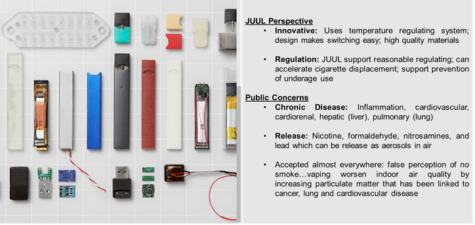Electronic Cigarette Customization Matters.
Electronic nicotine delivery systems (ENDS) are increasingly popular as an alternative to standard ‘combustion’ cigarettes. ENDS come in a large variety of forms and offer adulterant choices that enhance the user’s experience, such as flavors, humectants, and nicotine in different concentrations. There is a common perception that vaping is a safer alternative to traditional tobacco cigarettes as the ‘smoke’ lacks tars and other toxicants found in cigarette smoke(1). That may be true to some extent, however the ability of users to modify ENDS, like adjusting the power wattage, changing the type of heating element, and use of e-liquids with different flavor and nicotine concentrations, will influence the amounts of toxic chemicals in the inhaled aerosol. Under normal circumstances, the vapor contains, contrary to popular opinion, some of the same toxic compounds (formaldehyde, acetaldehyde, acrolein…) that are found in CCs (2). The ability to add custom adulterants to the vape fluid can add to the complexity of assessing potential risks. How modifications, or customizations might contribute to health effects and the generation of harmful chemicals is a topic that deserves more attention.
Devices are usually composed of a heating element, often a disposable metal heating coil, and atomizer tanks which directly produce the vapor. The most common heating coils and atomizer units can be comprised of different metals, such as stainless teel, nickel-chromium or nichrome, Kanthal nickel, or titanium. At usual setting these all work well, however they degrade with extended use. In some devices, users can set temperatures sufficiently high that degradation products of the device hardware such as metals are aerosolized and inhaled along with the vaporized e-liquid containing nicotine, flavoring, and solvents (3). Environmental metal contaminants are known risk factors for cardiovascular disease. Users of eC devices could inadvertently select vaping profiles that promote chemical reactions with the normally low-toxicity e-liquid to generate harmful chemicals in the aerosol they are inhaling at levels even exceeding traditional cigarettes.
Many studies have already brought insight into how device settings can generate levels of metals in inhaled aerosol that are unique to the modifiable aspects of eC devices. One study found increased concentrations of metals such as arsenic (As), chromium (Cr), copper (Cu), iron (Fe), manganese (Mn), nickel (Ni), lead (Pb), antimony (Sb), tin (Sn), and zinc (Zn) concentrations in eC aerosols when the device power is increased from low (20 Watts) to intermediate (40 Watts) settings (4). These exposure levels to metals like Ni from ENDS could exceed those of traditional reference cigarettes. It is interesting to note that ENDS from different manufactures emit different concentrations of metals, suggesting that heating and cooling patterns of individual devices could influence the amount of metals released. A similar study also found higher metal levels in aerosol and e-liquid after it comes in contact with the metal heating coil, compared to the original e-liquid in the dispenser vial (5). Elevated levels of metal biomarkers such as Cu, Cr, Sn, and Pb were found in the urine of electronic cigarette users. These studies highlight the need to further study how the unique customizable aspects of ENDS technology contribute to the formation of varying levels of contaminants in the inhaled aerosol. There is no question that smoking is a risk factor for cardiovascular disease and can increase blood pressure, heart rate, among other health outcomes. Educating the public about the health burden that ENDS pose and informing users about the potential dangers of vaping at elevated temperatures or using degraded heating components can be a step towards reducing use of new tobacco products.
References:
- Benowitz, N. L., & Burbank, A. D. (2016). Cardiovascular toxicity of nicotine: Implications for electronic cigarette use. Trends in cardiovascular medicine, 26(6), 515–523. https://doi.org/10.1016/j.tcm.2016.03.001
- Perraud, V., M.J. Lawler, K.T. Malecha, R.M. Johnson, D.A. Herman, N. Staimer et al.: Chemical characterization of nanoparticles and volatiles present in mainstream hookah smoke. Aerosol Science and Technology 53(9): 1023-1039 (2019)
- Wylie, B. J., Hauptman, M., Hacker, M. R., & Hawkins, S. S. (2021). Understanding Rising Electronic Cigarette Use. Obstetrics and gynecology, 137(3), 521–527. https://doi.org/10.1097/AOG.0000000000004282
- Zhao, D., Navas-Acien, A., Ilievski, V., Slavkovich, V., Olmedo, P., Adria-Mora, B., Domingo-Relloso, A., Aherrera, A., Kleiman, N. J., Rule, A. M., & Hilpert, M. (2019). Metal concentrations in electronic cigarette aerosol: Effect of open-system and closed-system devices and power settings. Environmental research, 174, 125–134. https://doi.org/10.1016/j.envres.2019.04.003
- Olmedo, P., Rodrigo, L., Grau-Pérez, M., Hilpert, M., Navas-Acién, A., Téllez-Plaza, M., Pla, A., & Gil, F. (2021). Metal exposure and biomarker levels among e-cigarette users in Spain. Environmental research, 202, 111667. Advance online publication. https://doi.org/10.1016/j.envres.2021.111667
- Bhatnagar A, Whitsel LP, Blaha MJ, Huffman MD, Krishan-Sarin S, Maa J, Rigotti N, Robertson RM, Warner JJ; on behalf of the American Heart Association. New and emerging tobacco products and the nicotine endgame: the role of robust regulation and comprehensive tobacco control and prevention: a presidential advisory from the American Heart Association. 2019;139:e937–e958. doi: 10.1161/CIR.0000000000000669.
“The views, opinions and positions expressed within this blog are those of the author(s) alone and do not represent those of the American Heart Association. The accuracy, completeness and validity of any statements made within this article are not guaranteed. We accept no liability for any errors, omissions or representations. The copyright of this content belongs to the author and any liability with regards to infringement of intellectual property rights remains with them. The Early Career Voice blog is not intended to provide medical advice or treatment. Only your healthcare provider can provide that. The American Heart Association recommends that you consult your healthcare provider regarding your personal health matters. If you think you are having a heart attack, stroke or another emergency, please call 911 immediately.”

